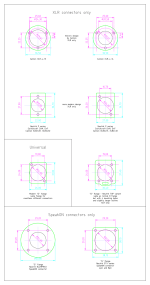Hi folks,
I'm a huge fan of connectors that have the "D" flange. So many different connectors share the same panel cut-out and can be interchanged.
I tried to find out about the history and background of the connector flange, but didn't find anything, not even a Wikipedia article.
This seems to be around for ages.
I'm not even sure how to call this kind of flange correctly. "D" series or "D" flange or something entirely different? Something with "D" it seems, which is a bit un-intuitive since there isn't anything "D" shaped, unlike the Sub-D connectors for example.
Does anybody know where this originates from? Which company popularized it?
It seems this stems from outside the US since the metric numbers are straight. Neutrik probably?
Thanks for any hints!
I'm a huge fan of connectors that have the "D" flange. So many different connectors share the same panel cut-out and can be interchanged.
I tried to find out about the history and background of the connector flange, but didn't find anything, not even a Wikipedia article.
This seems to be around for ages.
I'm not even sure how to call this kind of flange correctly. "D" series or "D" flange or something entirely different? Something with "D" it seems, which is a bit un-intuitive since there isn't anything "D" shaped, unlike the Sub-D connectors for example.
Does anybody know where this originates from? Which company popularized it?
It seems this stems from outside the US since the metric numbers are straight. Neutrik probably?
Thanks for any hints!
Attachments
I think that it all goes back to the "Cannon" connector which was invented by James Cannon as far back as 1915. Commonly referred to as "XLR connectors" of various pin configurations.
As technology evolved, the basic architecture of the chassis connector was adapted to house other forms of connector e.g. USB.
As technology evolved, the basic architecture of the chassis connector was adapted to house other forms of connector e.g. USB.
Makes sense that the XLR connector was first using this flange design.
Since Neutrik improved the XLR connector design, they may have introduced the metric dimensions.
If I remember correctly, in the past it was more common that the male connector had a different flange design with all holes on the vertical bore center axis.
Since Neutrik improved the XLR connector design, they may have introduced the metric dimensions.
If I remember correctly, in the past it was more common that the male connector had a different flange design with all holes on the vertical bore center axis.
Addendum:
Indeed the old flange design is different:
The Switchcraft D*M, D*F and Cannon XLB2*31, XLB2*32 use aforementioned design for the male connector and while the female flange looks similar to the modern design, it isn't.
See Neutrik NC3FP and NC3MP for details.
Indeed the old flange design is different:
The Switchcraft D*M, D*F and Cannon XLB2*31, XLB2*32 use aforementioned design for the male connector and while the female flange looks similar to the modern design, it isn't.
See Neutrik NC3FP and NC3MP for details.
I'm not at all clear as to when the "Neutrik" type mounting flange as shown in your first post became universally accepted. but Neutrik themselves also still offer chassis connectors with the narrower flange with the two mounting holes on the center line of the connector.
Circular mounting flanges were also quite widely used, but they take up more panel space.
Circular mounting flanges were also quite widely used, but they take up more panel space.

